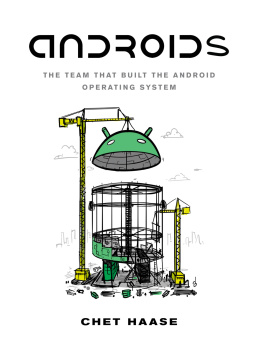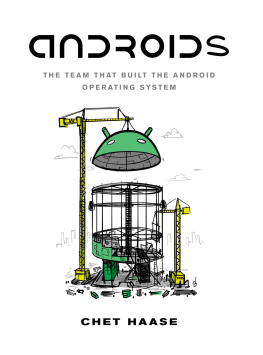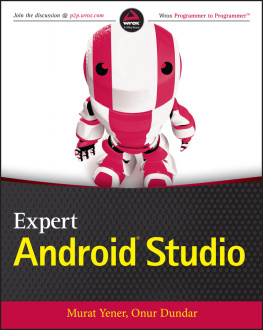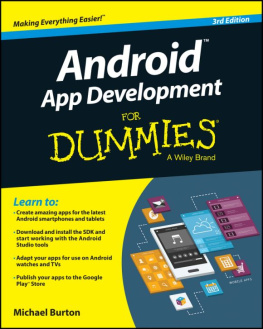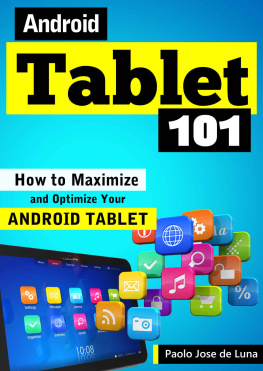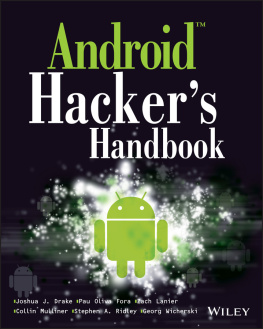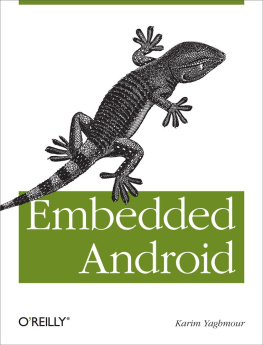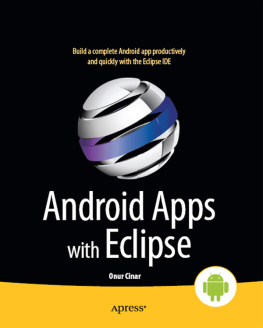
The team that built the Android operating system
Also by Chet Haase
Round & Holy
An Homage to Donuts
When I am King...
When I am King... II
Filthy Rich Clients
Developing Animated and Graphical Effects
for Desktop Java Applications
(with Romain Guy)
Flex 4 Fun

The team that built the Android operating system

Chet Haase
C opyright 2021 by Chet Haase
All Rights Reserved
First Edition
Cover art and illustrations by Dan Sandler
Cover and book design by Gretchen Achilles
ISBN 978-1-7373548-2-6 (color)
ISBN 978-1-7373548-1-9 (b&w)
ISBN 978-1-7373548-4-0 (eBook)
Website: www.chethaase.com/androids
Twitter: twitter.com/chethaase (@chethaase)
All profits from this book will be donated to charity
Integer.MAX_VALUE 8 4 2 1
To Kris:
First reader, last reviewer,
toughest critic, best friend
Any time anything works out, if you dont acknowledge the huge luck factor, youre kind of a jerk.
ficus kirkpatrick
(Listed in order of appearance on the Android team)
Note: This list is not complete; it is mostly limited to the people I interacted with directly about this book. There were many other people on the Android team at that time who contributed substantially to the product.
Cast Member: Role
Andy Rubin: Founder, robot maker
Chris White: Founder, designer, engineer, electric skateboarder
Tracey Cole: Administrative business partner, manager of managers
Brian Swetland: Engineer, kernel hacker, systems team lead
Rich Miner: Founder, mobile entrepreneur
Nick Sears: Founder, carrier deal-maker
Andy McFadden: Engineer, demo/calendar/simulator/ runtime developer
Ficus Kirkpatrick: Engineer, kernel driver driver, Crazy ringtoner
Wei Huang: Engineer, browser, communicator
Dan Bornstein: Engineer, Dalvik creator
Mathias Agopian: Engineer, graphics flinger
Joe Onorato: Engineer, build, UI, framework, and more
Eric Fischer: Engineer, Mr. TextView
Mike Fleming: Engineer, telephony and runtimes
Jeff Yaksick: Designer, toys and UIs
Cary Clark: Engineer, browser graphics
Mike Reed: Skia lead, serial graphics entrepreneur
Dianne Hackborn: Engineer, framework. Most of it.
Jeff Hamilton: Engineer, Binder, database, and contacts
Steve Horowitz: Engineering manager, compromiser
Mike Cleron: Engineer, UI toolkit rewriter and framework manager
Grace Kloba: Engineer, Android browser
Arve Hjnnevg: Engineer, drivers and debugging: few words, much code
Hiroshi Lockheimer: TPM, manager of partners
Jason Parks: Engineer, jparks broke it
Iliyan Malchev: Engineer, Bluetooth, camera, and other drivers
Cdric Beust: Engineer, Gmailer
David Turner: Engineer, Android emulator and more
Debajit Ghosh: Engineer, in service of Calendar
Marco Nelissen: Engineer, sound code
Ryan PC Gibson: TPM, release namer and shipper
Evan Millar: Engineer, testing, testing
Xavier Ducrohet: Engineer, tool tech, totally
Michael Morrissey: Engineering lead, servicing server services
Bob Lee: Engineer, core libraries
Romain Guy: Engineer, UI toolkit intern extraordinaire
Tom Moss: Lawyer, business development, deal maker
Brian Jones: Receptionist, admin, device hook-up guy
Dan Egnor: Engineer, over-the-air updater
Dave Sparks: Engineer, media manager
Peisun Wu: TPM, media, messaging, and donut burgers
Ed Heyl: Engineer, build. test. release. repeat.
Dirk Dougherty: Tech writer, RTFM
Charles Mendis: Engineer, location navigator
Dave Burke: Engineering lead, London mobile team
Andrei Popescu: Engineering lead, London browser team
Nicolas Roard: Engineer, gearing up for Android browser
San Mehat: Engineer, kernel drivers and SD card debugging
Nick Pelly: Engineer, Bluetooth wrangler
Rebecca Zavin: Engineer, device bringup, Droid driver
Chiu-Ki Chan: Engineer, checking in
Mike Chan: Engineer, kernel security
Bruce Gay: Engineer, monkey keeper
Jeff Sharkey: Engineer, contest winner
Jesse Wilson: Engineer, terrible API mitigator
Dan Sandler: Engineer, System UI, illustrator, Easter egger

Introduction

I n mid-May of 2010, I walked into building 44 on the Google campus for my first day on the Android team. Not far from my desk were at least a half-dozen machines for brewing a wide variety of great, strong coffee. I was surprised at the focus on caffeine, but not for long.
The team was finishing up one release in parallel. Both were difficult, time-consuming, and critical as we tried to make Android relevant in the crowded smartphone market at that time. There was a constant feeling of racing furiously toward a goal, doing whatever we could to reach it and not knowing if we would. The pace was frantic, but the work was exhilaratingand not just because of the caffeine. The excitement came from being on a team singularly dedicated to its purpose, no matter how much effort it took.
Working on Android was a stark difference from where my career began.
I started my work life with a nine-to-five job at a conservative old firm in Minnesota. The company relied on people sticking around for their entire careers and beyond, offering retirees a free turkey every Thanksgiving. I was all set; I just needed to clock in my forty hours a week and rise slowly through the ranks until I was ready for my retirement and my turkey.
Within a year, I was bored out of my mind, and within two Id left for graduate school, to reboot my skills into something I actually enjoyed: computer Sun Microsystems, where I thrived for the next couple of years until another interesting job beckoned.
I spent the next several years moving from company to company as other jobs, technologies, and people offered a continually shifting variety in my tech life. I worked at Sun (a few different times), Anyware Fast (a contracting company started by a couple of friends), DimensionX (an early web startup acquired by Microsoft), Intel, Rendition (a 3D chip startup acquired by Micron), and Adobe.
My father, who retired from the U.S. Navy after 21 years, was never comfortable with my frequent job changes. What about a pension? What about job security? What about stability for my family?
What he didnt see was that this was the way things were, and are, in Silicon Valley, and increasingly in high tech everywhere. For every job I started, I built a new set of skills that contributed to future prospects and products. That same attitude, and reality, applies to all of the engineers shifting between tech firms; were building skills that well continue to draw from as we move around creating all kinds of products. Its exactly these diverse backgrounds that contribute much-needed skills to new projects, to tackle unknown problems and deliver innovative solutions.
In 2010, another opportunity presented itself. UI toolkit team in Building 44 on the Google campus in Mountain View and started working harder than I ever had before.
Next page
